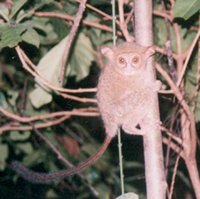Tarsier
|
|
| Tarsiers | ||||||||||||||
|---|---|---|---|---|---|---|---|---|---|---|---|---|---|---|
 Spectral Tarsier | ||||||||||||||
| Scientific classification | ||||||||||||||
| ||||||||||||||
| Species | ||||||||||||||
|
Tarsius syrichta |
Tarsiers (family Tarsiidae, genus Tarsius) are a genus of prosimian primates, previously classified as strepsirhines, but now classified as haplorhines, though still not considered to be monkeys. Tarsiers have enormous eyes and long feet. Their feet have extremely elongated tarsus bones, which is how they got their name. They are primarily insectivorous, and catch insects by jumping at them. They are also known to prey on birds and snakes. Once found in Asia, Europe and North America, tarsiers are now only found on several Southeast Asian islands including the Philippines, Sulawesi, Borneo, and Sumatra. Their conservation status has been classified as "Lower Risk/Conservation Dependent". When caged, some Tarsiers have been known to injure and even kill themselves because of the stress [1] (http://web.archive.org/web/20041015083950/http://www.szgdocent.org/pp/p-tarsir.htm).
Classification
- Infraorder Tarsiiformes
- Family Tarsiidae: tarsiers
- Genus Tarsius
- T. syrichta group
- Philippine Tarsier, Tarsius syrichta
- Western or Horsfield's Tarsier, Tarsius bancanus
- Tarsius bancanus bancanus
- Tarsius bancanus saltator
- Tarsius bancanus borneanus
- T. tarsier group
- Spectral Tarsier, Tarsius tarsier
- Dian's Tarsier, Tarsius dentatus
- Peleng Tarsier, Tarsius pelengensis
- Sangihe Tarsier, Tarsius sangirensis
- Pygmy Tarsier, Tarsius pumilus
- T. syrichta group
- Genus Tarsius
- Family Tarsiidae: tarsiers
Tarsier2.jpg
